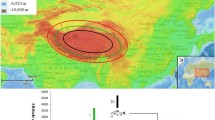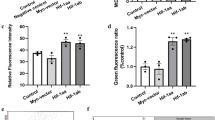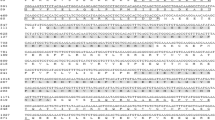Abstract
The long evolution of the Antarctic perciform suborder of Notothenioidei in the icy, oxygen-rich waters of the Southern Ocean may have reduced selective pressure to maintain a hypoxic response. To test this hypothesis, cDNA of the key transcriptional regulator of hypoxic genes, hypoxia-inducible factor-1α (HIF-1α), was sequenced in heart ventricles of the red-blooded notothenioid, Notothenia coriiceps, and the hemoglobinless icefish, Chaenocephalus aceratus. HIF-1α cDNA is 4500 base pairs (bp) long and encodes 755 amino acids in N. coriiceps, and in C. aceratus, HIF-1α is 3576 bp long and encodes 779 amino acids. All functional domains of HIF-1α are highly conserved compared to other teleosts, but HIF-1α contains a polyglutamine/glutamic acid (polyQ/E) insert nine amino acids long in N. coriiceps and 34 amino acids long in C. aceratus. Sequencing of this region in four additional species, representing three families of notothenioids, revealed that the length of the polyQ/E insert varies with phylogeny. Icefishes, the crown family of notothenioids, contain the longest polyQ/E inserts, ranging between 16 and 34 amino acids long, whereas the basal, cold-temperate notothenioid, Eleginops maclovinus, contains a polyQ/E insert only 4 amino acids long. PolyQ/E inserts may affect dimerization of HIF-1α and HIF-1β, HIF-1 translocation into the nucleus and/or DNA binding.




Similar content being viewed by others
References
Anttila K, Dhillon RS, Boulding EG, Farrell AP, Glebe BD, Elliott JAK, Wolters WR, Schulte PM (2013) Variation in temperature tolerance among families of Atlantic salmon (Salmo salar) is associated with hypoxia tolerance, ventricle size and myoglobin level. J Exp Biol 216:1183–1190. doi:10.1242/jeb.080556
Beers JM, Sidell BD (2011) Thermal tolerance of Antarctic notothenioid fishes correlates with level of circulating hemoglobin. Physiol Biochem Zool 84:353–362. doi:10.1086/660191
Berta M, Brahimi-Horn C, Pouyssegur J (2004) Regulation of the hypoxia-inducible factor-1alpha (HIF-1alpha): a breath of fresh air in hypoxia research. J Soc Biol 198:113–120
Bilyk KT, Cheng C-HC (2014) RNA-seq analyses of cellular responses to elevated body temperature in the high Antarctic cryopelagic nototheniid fish Pagothenia borchgrevinki. Mar Genom 18:163–171. doi:10.1016/j.margen.2014.06.006
Cao Y-B, Chen X-Q, Wang S, Wang Y-X, Du J-Z (2008) Evolution and regulation of the downstream gene of hypoxia-inducible factor-1α in naked carp (Gymnocypris przewalskii) from Lake Qinghai, China. J Mol Evol 67:570–580. doi:10.1007/s00239-008-9175-4
Chen Z, Cheng C-HC, Zhang J, Cao L, Chen L, Zhou L, Jin Y, Ye H, Deng C, Dai Z, Xu Q, Hu P, Sun S, Shen Y, Chen L (2008) Transcriptomic and genomic evolution under constant cold in Antarctic notothenioid fish. Proc Natl Acad Sci USA 105:12944–12949. doi:10.1073/pnas.0802432105
Clark TD, Sandblom E, Cox GK, Hinch SG, Farrell AP (2008) Circulatory limits to oxygen supply during an acute temperature increase in the Chinook salmon (Oncorhynchus tshawytscha). Am J Physiol-Regul Integr Comp Physiol 295:R1631–R1639. doi:10.1152/ajpregu.90461.2008
Davie PS, Farrell AP (1991) The coronary and luminal circulations of the myocardium of fishes. Can J Zool 69:1993–2001. doi:10.1139/z91-278
Detrich HW, Prasad V, Ludueña RF (1987) Cold-stable microtubules from Antarctic fishes contain unique alpha tubulins. J Biol Chem 262:8360–8366
Devor DP, Kuhn DE, O’Brien KM, Crockett EL (2016) Hyperoxia does not extend critical thermal maxima (CT max) in white- or red-blooded antarctic notothenioid fishes. Physiol Biochem Zool 89:1–9. doi:10.1086/684812
DeVries AL, Wohlschlag DE (1969) Freezing resistance in some Antarctic fishes. Science 163:1073–1075
Duyao M, Ambrose C, Myers R, Novelletto A, Persichetti F, Frontali M, Folstein S, Ross C, Franz M, Abbott M, Gray J, Conneally P, Young A, Penney J, Hollingsworth Z, Shoulson I, Lazzarini A, Falek A, Koroshetz W, Sax D, Bird E, Vonsattel J, Bonilla E, Alvir J, Bickham Conde J, Cha J-H, Dure L, Gomez F, Ramos M, Sanchez-Ramos J, Snodgrass S, de Young M, Wexler N, Moscowitz C, Penchaszadeh G, MacFarlane H, Anderson M, Jenkins B, Srinidhi J, Barnes G, Gusella J, MacDonald M (1993) Trinucleotide repeat length instability and age of onset in Huntington’s disease. Nat Genet 4:387–392. doi:10.1038/ng0893-387
Eastman JT (1993) Antarctic fish biology: evolution in a unique environment. Academic Press, San Diego
Eastman JT (2005) The nature of the diversity of Antarctic fishes. Polar Biol 28:93–107. doi:10.1007/s00300-004-0667-4
Eliason EJ, Clark TD, Hague MJ, Hanson LM, Gallagher ZS, Jeffries KM, Gale MK, Patterson DA, Hinch SG, Farrell AP (2011) Differences in thermal tolerance among sockeye Salmon populations. Science 332:109–112. doi:10.1126/science.1199158
Ely BR, Lovering AT, Horowitz M, Minson CT (2014) Heat acclimation and cross tolerance to hypoxia. Temperature 1:107–114. doi:10.4161/temp.29800
Gerber H-P, Seipel K, Georgiev O, Höfferer M, Hug M, Rusconi S, Schaffner W (1994) Transcriptional activation modulated by homopolymeric glutamine and proline stretches. Science 263:808–811. doi:10.1126/science.8303297
Gidalevitz T, Ben-Zvi A, Ho KH, Brignull HR, Morimoto RI (2006) Progressive disruption of cellular protein folding in models of polyglutamine diseases. Science 311:1471–1474. doi:10.1126/science.1124514
Hofmann GE, Buckley BA, Airaksinen S, Keen JE, Somero GN (2000) Heat-shock protein expression is absent in the Antarctic fish Trematomus bernacchii (family Nototheniidae). J Exp Biol 203:2331–2339
Hon W-C, Wilson MI, Harlos K, Claridge TDW, Schofield CJ, Pugh CW, Maxwell PH, Ratcliffe PJ, Stuart DI, Jones EY (2002) Structural basis for the recognition of hydroxyproline in HIF-1α by pVHL. Nature 417:975–978. doi:10.1038/nature00767
Hong S-S, Lee H, Kim K-W (2004) HIF-1α: a valid therapeutic target for tumor therapy. Cancer Res Treat 36:343–353. doi:10.4143/crt.2004.36.6.343
Huth TJ, Place SP (2013) De novo assembly and characterization of tissue specific transcriptomes in the emerald notothen, Trematomus bernacchii. BMC Genomics 14:805. doi:10.1186/1471-2164-14-805
Huth TJ, Place SP (2016) RNA-seq reveals a diminished acclimation response to the combined effects of ocean acidification and elevated seawater temperature in Pagothenia borchgrevinki. Mar Genom 28:87–97. doi:10.1016/j.margen.2016.02.004
Ivan M, Kondo K, Yang H, Kim W, Valiando J, Ohh M, Salic A, Asara JM, Lane WS, Kaelin WG (2001) HIFalpha targeted for VHL-mediated destruction by proline hydroxylation: implications for O2 sensing. Science 292:464–468. doi:10.1126/science.1059817
Jaakkola P, Mole DR, Tian Y-M, Wilson MI, Gielbert J, Gaskell SJ, von Kriegsheim A, Hebestreit HF, Mukherji M, Schofield CJ, Maxwell PH, Pugh CW, Ratcliffe PJ (2001) Targeting of HIF-alpha to the von Hippel-Lindau ubiquitylation complex by O2-regulated prolyl hydroxylation. Science 292:468–472. doi:10.1126/science.1059796
Jiang B-H, Zheng JZ, Leung SW, Roe R, Semenza GL (1997) Transactivation and inhibitory domains of hypoxia-inducible factor 1α. Modulation of transcriptional activity by oxygen tension. J Biol Chem 272:19253–19260. doi:10.1074/jbc.272.31.19253
Kumar S, Stecher G, Tamura K (2016) MEGA7: molecular evolutionary genetics analysis version 7.0 for bigger datasets. Mol Biol Evol 33:1870–1874. doi:10.1093/molbev/msw054
Lando D, Peet DJ, Whelan DA, Gorman JJ, Whitelaw ML (2002) Asparagine hydroxylation of the HIF transactivation domain a hypoxic switch. Science 295:858–861. doi:10.1126/science.1068592
Min J-H, Yang H, Ivan M, Gertler F, Kaelin WG, Pavletich NP (2002) Structure of an HIF-1alpha -pVHL complex: hydroxyproline recognition in signaling. Science 296:1886–1889. doi:10.1126/science.1073440
Nalavade R, Griesche N, Ryan DP, Hildebrand S, Krauß S (2013) Mechanisms of RNA-induced toxicity in CAG repeat disorders. Cell Death Dis 4:e752. doi:10.1038/cddis.2013.276
Near TJ, Dornburg A, Kuhn KL, Eastman JT, Pennington JN, Patarnello T, Zane L, Fernández DA, Jones CD (2012) Ancient climate change, antifreeze, and the evolutionary diversification of Antarctic fishes. Proc Natl Acad Sci USA 109:3434–3439. doi:10.1073/pnas.1115169109
Podrabsky JE (2004) Changes in gene expression associated with acclimation to constant temperatures and fluctuating daily temperatures in an annual killifish Austrofundulus limnaeus. J Exp Biol 207:2237–2254. doi:10.1242/jeb.01016
Römisch K, Collie N, Soto N, Logue J, Lindsay M, Scheper W, Cheng C-HC (2003) Protein translocation across the endoplasmic reticulum membrane in cold-adapted organisms. J Cell Sci 116:2875–2883. doi:10.1242/jcs.00597
Rost B, Yachdav G, Liu J (2004) The PredictProtein server. Nucl Acids Res 32:W321–W326. doi:10.1093/nar/gkh377
Sandblom E, Clark TD, Gräns A, Ekström A, Brijs J, Sundström LF, Odelström A, Adill A, Aho T, Jutfelt F (2016) Physiological constraints to climate warming in fish follow principles of plastic floors and concrete ceilings. Nat Commun 7:11447. doi:10.1038/ncomms11447
Schaefer MH, Wanker EE, Andrade-Navarro MA (2012) Evolution and function of CAG/polyglutamine repeats in protein-protein interaction networks. Nucl Acids Res 40:4273–4287. doi:10.1093/nar/gks011
Scherzinger E, Lurz R, Turmaine M, Mangiarini L, Hollenbach B, Hasenbank R, Bates GP, Davies SW, Lehrach H, Wanker EE (1997) Huntingtin-encoded polyglutamine expansions form amyloid-like protein aggregates in vitro and in vivo. Cell 90:549–558. doi:10.1016/S0092-8674(00)80514-0
Semenza GL (2004) Hydroxylation of HIF-1: oxygen sensing at the molecular level. Physiology 19:176–182. doi:10.1152/physiol.00001.2004
Semenza GL, Agani F, Booth G, Forsythe J, Iyer N, Jiang BH, Leung S, Roe R, Wiener C, Yu A (1997) Structural and functional analysis of hypoxia-inducible factor 1. Kidney Int 51:553–555
Shin SC, Ahn DH, Kim SJ, Pyo CW, Lee H, Kim M-K, Lee J, Lee JE, Detrich HW, Postlethwait JH, Edwards D, Lee SG, Lee JH, Park H (2014) The genome sequence of the Antarctic bullhead notothen reveals evolutionary adaptations to a cold environment. Genome Biol 15:468. doi:10.1186/s13059-014-0468-1
Sidell BD, Vayda ME, Small DJ, Moylan TJ, Londraville RL, Yuan M-L, Rodnick KJ, Eppley ZA, Costello L (1997) Variable expression of myoglobin among the hemoglobinless Antarctic icefishes. Proc Natl Acad Sci USA 94:3420–3424. doi:10.1073/pnas.94.7.3420
Sollid J, Rissanen E, Tranberg HK, Thorstensen T, Vuori KA, Nikinmaa M, Nilsson GE (2006) HIF-1α and iNOS levels in crucian carp gills during hypoxia-induced transformation. J Comp Physiol B Biochem Syst Environ Physiol 176:359–369. doi:10.1007/s00360-005-0059-2
Somero GN, DeVries AL (1967) Temperature tolerance of some Antarctic fishes. Science 156:257–258
Tamura K, Nei M (1993) Estimation of the number of nucleotide substitutions in the control region of mitochondrial DNA in humans and chimpanzees. Mol Biol Evol 10:512–526. doi:10.1093/molbev/msl149
Treinin M, Shliar J, Jiang H, Powell-Coffman JA, Bromberg Z, Horowitz M (2003) HIF-1 is required for heat acclimation in the nematode Caenorhabditis elegans. Physiol Genomics 14:17–24. doi:10.1152/physiolgenomics.00179.2002
Yachdav G, Kloppmann E, Kajan L, Hecht M, Goldberg T, Hamp T, Hönigschmid P, Schafferhans A, Roos M, Bernhofer M, Richter L, Ashkenazy H, Punta M, Schlessinger A, Bromberg Y, Schneider R, Vriend G, Sander C, Ben-Tal N, Rost B (2014) PredictProtein–an open resource for online prediction of protein structural and functional features. Nucl Acids Res 42:W337–W343. doi:10.1093/nar/gku366
Yang Z (2007) PAML 4: phylogenetic analysis by maximum likelihood. Mol Biol Evol 24:1586–1591. doi:10.1093/molbev/msm088
Zoghbi HY, Orr HT (2000) Glutamine repeats and neurodegeneration. Annu Rev Neurosci 23:217–247. doi:10.1146/annurev.neuro.23.1.217
Acknowledgements
Funding was provided by a grant from the National Science Foundation (PLR-1341663 to KOB). A.R. was supported in part by a graduate fellowship from an Institutional Development Award (IDeA) from the National Institute of General Medical Sciences of the National Institutes of Health (NIH) (P20GM103395). The content of this work is solely the responsibility of the authors and does not necessarily reflect the official views of the NIH. Thanks to Dr. Chi-Hing Christina Cheng for providing samples of E. maclovinus.
Author information
Authors and Affiliations
Corresponding author
Rights and permissions
About this article
Cite this article
Rix, A.S., Grove, T.J. & O’Brien, K.M. Hypoxia-inducible factor-1α in Antarctic notothenioids contains a polyglutamine and glutamic acid insert that varies in length with phylogeny. Polar Biol 40, 2537–2545 (2017). https://doi.org/10.1007/s00300-017-2164-6
Received:
Revised:
Accepted:
Published:
Issue Date:
DOI: https://doi.org/10.1007/s00300-017-2164-6




